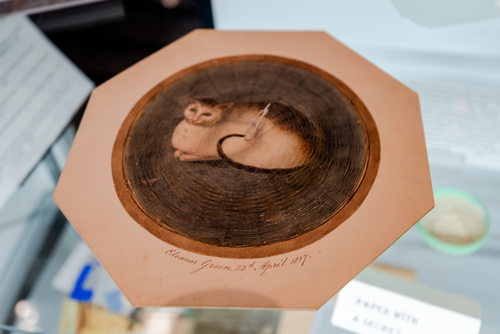A moment with the Greenwich Ephemera Festival
The Ephemera Society of America (ESA) held its forty-fourth annual fair at the Greenwich Hyatt from March 15 to March 17. The three-day event gathered collectors in the hotel’s ballroom to buy, sell, and trade ephemera, a broad class of items which can include antiques and collectibles, but largely consists of things that were not intended to last.
“Ephemera is something that was intended to be short lived. An advertising flyer, a campaign button, a ticket,” said Sheryl Jaeger, the co-owner of Eclectibles, based in Tolland, Connecticut. “Anything that anyone would receive and most likely throw away.”
Among the items Jaeger was selling at the fair was a “cobweb” valentine made in 1817, recently featured in the New York Times and worth $2,400. The card features a painting of a cat when flat but reveals mice in a cage when a string in its center is gently lifted up.


“A flower is ephemeral,” Jaeger said as she displayed what might be her most notable piece. “A flower is only intended to last for a couple of days.”

Despite the considerable monetary value of many of the things on sale at the Greenwich Ephemera Fair, many of those who hold down booths also find themselves engaged in swaps and trades driven less by potential profit and more by personal passion.
David Lilburne, the current president of the ESA is a bookseller at Antipodean Books by trade owing to a lifelong interest in paper. He feels a special connection to the Greenwich Ephemera Fair as it led him to discover the subject of his personal collection shortly after he relocated to the US from London, England.
“I was playing Rugby in White Plains, and one of the guys I was playing with was a tea taster,” Lilburne recalled. “He had a birthday coming up and invited me to the party. In between that game and the party this fair occurred so I came here and said, ‘who has some tea bits?’”
Lilburne managed to find the perfect gift for his friend, antique tea packets, a relevant photograph, and some other paraphernalia.
“I put them in the package, I took them over to his birthday party, as I gave it to him I said, ‘oh I want them back,’” he recounted with a dramatic moan. “I’ve been trying to get them ever since, but he loved them, so I went ‘I’m going to collect tea.’”
“Now I have four and a half thousand pieces of paper on tea.”
Despite his passion for tea ephemera driving his hunts at the fair, Lilburne said he keeps a strict line between pleasure and business when it comes to ephemera, only selling the occasional duplicate item through his own stall at the fair.
“When you’re selling you shouldn’t be collecting,” he said. “See, the beauty of the ephemera society is we’ve got different groups. We’ve got the dealers like me and then you’ve got the collectors and then you’ve got the institutions. We all come at things from different angles.”
Another aspect of history which has produced a considerable amount of ephemera is entertainment. Brooklyn-based Gabe Boyers who runs Shubertiade Music and Art as well as the “B” Dry Goods Gallery described his focus as “music and the performing arts predominantly, but other things as well.”
Those other things range from a wallet used by Hans Christian Anderson, letters sent by Truman Capote, and a pair of boxers once worn by Brad Pitt during a photo shoot for Vanity Fair.

Boyers, who is still a performing violinist and among the younger vendors at the fair, said that his business grew out of learning more as an arts student.
“I started collecting stuff related to the performers and composers that I was sort of consumed with thinking about,” Boyers explained. “Like most collectors that eventually led to some wheeling and dealing, just trading up to support the habit, then when I finished music school one thing led to another and I sort of decided to go into business.”
Lisa F. Bouchard, who runs Melrose Books & Art based in Providence Rhode Island, discussed another facet of the business, the increasing presence of librarians and archivists at the event.
“We do a lot of archives these days because they’re things that tell the story. They’re not one piece anymore but like an archive of 50 photos or 80 letters,” Bouchard said.
“Our business has become a lot more institutional. There are a lot of colleges and universities who have been given grants and endowments to really beef up their holdings around social justice.”
She also explained that while modern ephemera is distinct, there is still plenty of physical evidence being produced that will fuel future collections. Signs from protests ranging from the Black Lives Matter marches of several years ago to the physical signs calling for a ceasefire in Gaza today. Those items will one day become opportunities for somebody to touch a piece of history.
And unlike some fields which explore the past, at the Ephemera Fair there is often encouragement to literally touch the past.
“We want you to have clean hands,” said Lilburndismissing the idea of using white gloves which he said can cause more damage than they prevent, “but we’re not holding things in perpetuity like a museum is.”
“You come here. You actually touch the paper, and paper will talk to you. I encourage anybody to pick it up, look at it, hold it to the light, look through it, see it from the back. Think of the history. It invokes all these passions where a digital presence does not,” Lilburn said. “Something’s going to talk to you and you’re going to pick it up.”